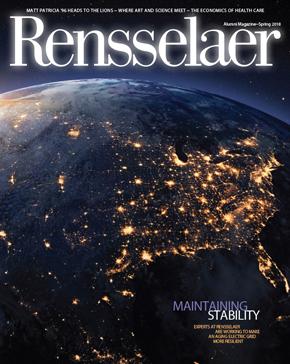
From Our Readers
Co-Terminal Program Valued
I enjoyed the article in the latest Rensselaer magazine about the co-terminal program (“Fast-Track to a Master’s Degree,” Fall 2017). I particularly found it interesting that it stated the program’s inception was in 2008 seeing as I graduated with both a B.S. and M.S. in computer science on the same day in 2000 after only eight semesters. Mind you, I had 17 semester hours of AP credit when I arrived at RPI and I took a class over one summer, but my senior year was tough balancing my remaining undergrad courses with my master’s project on top of my Air Force ROTC commitments. I recall the program I was accepted to that allowed me to earn both degrees simultaneously being called the “professional student” plan, or something like that.
Also note that I was required to take the GRE but was told that it was just a formality because of my undergrad GPA. Needless to say, I didn’t study very hard for it. I challenge every student to consider the co-terminal program. The experience I gained has helped me tremendously during my career. More specifically it was instrumental in landing an assignment as a professor of computer science at the Air Force Academy just four years after I graduated.
Gordon MacMillan ’00
Stuttgart, Germany
Remembering RAMP
I was reading the fall issue and the article “Fast-Track to a Master’s Degree” by Pam Allen (Fall 2017). When the article said, “The accelerated master’s program has grown every year since its inception in 2008,” I figured I would write in. Back in 1972 I signed up for a program at RPI called the RAMP — Rensselaer Accelerated Master Program. The RAMP program back then allowed you to take up to 21 credit hours a semester. By doing this I was able to get both my B.S. and master’s in mechanical engineering in just four years. I don’t know if/when the program was terminated. At the Hartford campus they had an accelerated night school MBA where you went every semester including summers and got the MBA in just two years. I think this program was changed. Thanks for the nice articles. I also liked the “Don’t Fly in 10 Years” commentary. It reminded me how technology has changed since I was in school. Started with a slide rule, graduated with a calculator. The computer came in 1984. When I started they had just dropped drafting at RPI and now we have CAD. Go figure?
Rob Kolp ’76
Ivoryton, Connecticut
Man-Made Fatigue
Lawrence Stoker wrote a very good article on metal fatigue but he didn’t include man-made fatigue (“Don’t Fly in 10 Years,” Fall 2017). In about 1978, the vice president of maintenance for American Airlines developed a new process of removing the engines from the wing. The normal process was lifting the engine by chains attached to the ceiling. He developed a quicker way by tuning a fork lift. The problem was, every time he used it, it weakened the attachment. The results: In 1979 an American DC-10 taking off from Chicago had an engine fall off and it killed 275 persons on board.
Larry Green ’46
Brooksville, Florida
Making Connections
If you’ve ever wondered whether the alums reading the magazine ever reach out to other alums, I have firsthand proof that they do. The Fall 2017 issue of the Rensselaer alumni magazine featured a photo of my ringing the opening bell at the New York Stock Exchange. About a week after it arrived in the mail, I received a note from an executive at a larger investment firm whose wife noticed the photo and asked if we knew each other. There are not a lot of us whose careers have taken us into the investment world and a previous search on LinkedIn failed to identify this person. So, kudos to the magazine for this very important connection.
Scott Sacknoff ’89
Bethesda, Maryland















